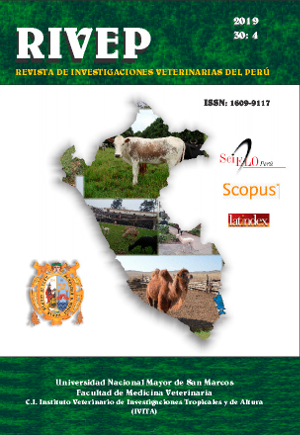Genotyping by RAPD-PCR of Yersinia ruckeri isolates from rainbow trout (Oncorhynchus mykiss) of the highlands of Peru
DOI:
https://doi.org/10.15381/rivep.v30i4.17148Keywords:
fish health, RAPD-PCR, yersiniosis, isolation, Yersinia ruckeriAbstract
The aim of this study was to identify Y. ruckeri genotypes, according to their origin, by RAPD-PCR. Aseptic samples of spleen and kidney were taken from rainbow trout (Oncorhynchus mykiss) with clinical signs of yersiniosis in fish farms of four departments (Junín, Lima, Ancash and Puno) of Peru. The strains were cultivated on trypticase soy agar at 25 °C for 24 hours and the presumptive identification of the colonies suspected of being Y. ruckeri was made by Gram stain and biochemical tests of oxidase and catalase. Then, the identity of Y. ruckeri was confirmed by PCR. In total, 63 isolates of Y. ruckeri were obtained and analyzed by RAPD-PCR. The dendogram of genetic diversity grouped all the isolates in one cluster, closely related to the control strain Y. ruckeri ATCC 29473 (96% similarity). It was also observed that all the isolates were genetically identical (clones). It is suggested that the strains could have a common origin because they had different geographical origins and high similarity between them.
Downloads
Downloads
Published
Issue
Section
License
Copyright (c) 2020 Fernando Mesías V., Enrique Serrano-Martínez, Luis Llanco A.

This work is licensed under a Creative Commons Attribution-NonCommercial-ShareAlike 4.0 International License.
AUTHORS RETAIN THEIR RIGHTS:
a. Authors retain their trade mark rights and patent, and also on any process or procedure described in the article.
b. Authors retain their right to share, copy, distribute, perform and publicly communicate their article (eg, to place their article in an institutional repository or publish it in a book), with an acknowledgment of its initial publication in the Revista de Investigaciones Veterinarias del Perú (RIVEP).
c. Authors retain theirs right to make a subsequent publication of their work, to use the article or any part thereof (eg a compilation of his papers, lecture notes, thesis, or a book), always indicating the source of publication (the originator of the work, journal, volume, number and date).










